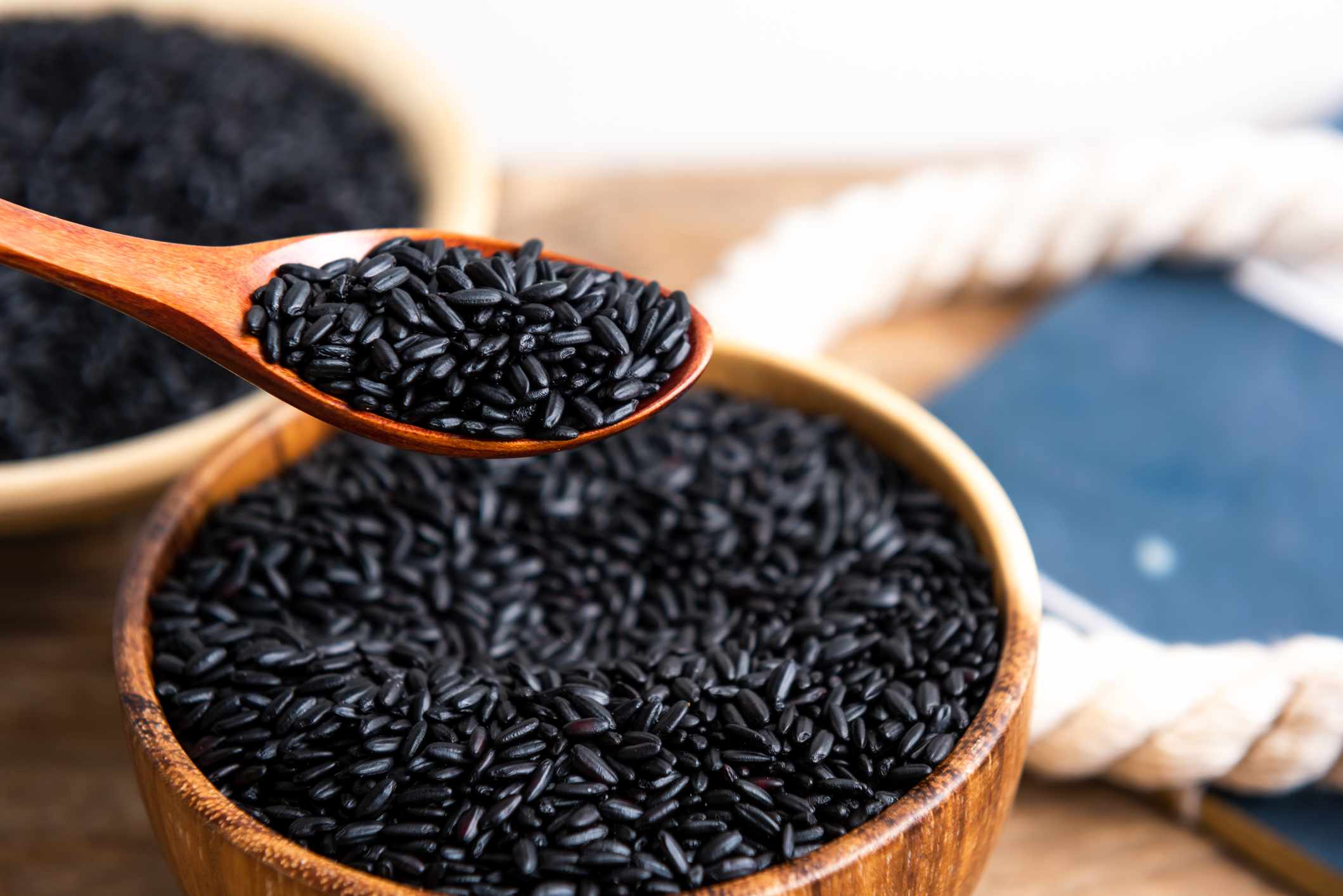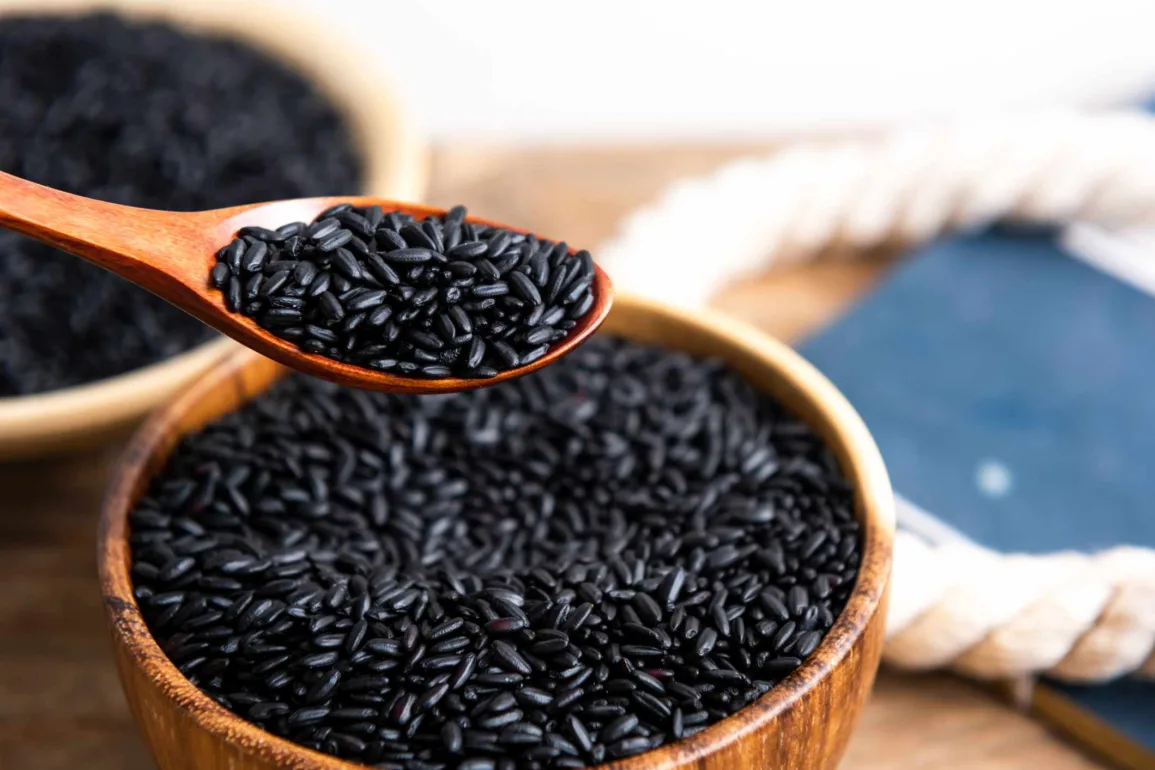
Black rice, also known as forbidden rice or purple rice, is a whole grain that’s been consumed in China, Korea, and Japan for centuries. In ancient China, black rice was reserved exclusively for emperors and wealthy people, hence the name “forbidden rice”. Since then, black rice has been used in traditional Chinese medicine to strengthen kidney function, promote circulation, and treat diabetes and anemia.
Now, black rice is available to purchase at many supermarkets or health food stores in the United States. Its chewy texture is somewhat comparable to brown rice, another whole-grain rice. Many people choose to eat black rice for its robust nutrient profile; it’s a good source of fiber and antioxidants that support health. The deep purple color of this rice is actually due to its anthocyanin content—a potent antioxidant that can help prevent various diseases.
Research shows black rice is a good source of various phytonutrients and antioxidants, including anthocyanins, glycosides, flavonols, and carotenoids.
Antioxidants are important because they help defend against oxidative stress. Oxidative stress is a bodily reaction that can damage our cells and contribute to diseases like cancer and heart disease. Eating foods rich in antioxidants is a good way to help prevent and reduce oxidative stress.
Black rice is one of the most antioxidant-dense rice options. One study found that compared to red and brown rice, black rice has the highest phytonutrient content and displays the most promise in fighting breast cancer cells.
Another study found consuming higher amounts of dietary flavonols, which are found in black rice, is associated with a reduced risk of colon cancer. However, we need more research to establish if and how consuming antioxidants can help prevent cancer.
It’s best to get antioxidants from food rather than supplements as research shows taking antioxidant supplements doesn’t have the same effect on reducing oxidative stress.
Eating black rice may support heart health due to its effect on cholesterol as a whole grain and its antioxidant properties.
Whole grains like black rice are higher in fiber than refined grains, and fiber helps keep your cholesterol levels in check. Since having high cholesterol increases your risk for heart disease, whole grains are a significant part of a heart-healthy diet.
The Dietary Guidelines for Americans recommend at least half of the grains you eat be whole grains. However, 98% of Americans fall below the recommended whole grain intake.
Large studies have found eating more whole grains is linked with a reduced risk of developing a variety of chronic diseases including cardiovascular disease and coronary heart disease.
The antioxidants in black rice may also support heart health. One study found that regularly consuming anthocyanins—the antioxidants that give black rice its color—was associated with a reduced risk of heart attack in patients older than 65 years old with normal blood pressure.
Research has shown getting anthocyanins from food seems to be more beneficial than taking antioxidant supplements. This could mean the various nutrients in foods like black rice work with the antioxidants to produce health benefits.
The fiber content of black rice isn’t only beneficial for heart health, but also for digestive health.
Fiber is a non-digestible carbohydrate that supports digestive regularity. There are two types of fiber: soluble and insoluble. The insoluble kind is most abundant in whole grains. This type of fiber helps keep things moving through your system and adds bulk to the stool to prevent or treat constipation.
Eating enough dietary fiber also supports a healthy gut microbiome. When fiber enters our digestive tract, it helps produce short-chain fatty acids that support our overall health.
An increasing amount of research has revealed that our gut microbiome—the diverse community of microorganisms in our digestive tract—also influences our brain health, immune health, and metabolic health. Supporting a healthy gut can help support your overall health and well-being.
Black rice is a whole grain that mainly consists of carbohydrates. Plus, it’s a pretty good source of fiber and protein. Here’s the nutrition breakdown of 0.25 cups of uncooked black rice:
- Calories: 180
- Fat: 1 gram (g)
- Sodium: 40 milligrams (mg), or 2% of the daily value (DV)
- Carbohydrates: 39 g
- Fiber: 5 g, or 18% of the DV
- Protein: 4 g
- Added sugars: 0 g
The color of black rice is a result of its high antioxidant content. It’s particularly high in anthocyanins which have been shown to help counter chronic inflammation and prevent chronic disease. Black rice extract is used increasingly as a functional food thanks to these antioxidants.
Black rice is a nutrient-rich food that’s safe for most people to consume. However, black rice is higher in fiber than other kinds of rice so it may cause gastrointestinal irritation for some people, particularly if you increase your fiber intake too quickly.
People with gastrointestinal diseases like irritable bowel syndrome (IBS) may also find the fiber content in black rice hard to tolerate, especially if it’s eaten with other high-fiber foods.
While black rice has been a part of some Asian cuisines for centuries, it’s not as common in the U.S.. Many Americans are more familiar with other kinds of rice, like white rice and brown rice. White rice is a refined grain, so it’s a bit lower in fiber than brown rice or black rice. It also doesn’t have the same antioxidant content.
Pairing white rice with sources of fiber and antioxidants can help create a well-rounded meal. You can also consume different whole grains throughout your day, like whole wheat bread or oatmeal, to increase your daily intake of whole grains.
Black rice can be prepared and consumed just like any other rice. Its texture is most similar to brown rice, so it substitutes well for brown rice in dishes like grain bowls, salads, or as a side dish.
You can incorporate black rice into your diet by:
- Using it as the base in a grain bowl topped with veggies and chicken or tofu
- Swapping it for white rice in rice pudding
- Adding it to a stir-fry with shrimp, peppers, mushrooms, snap peas, and other veggies
- Serving it as a side dish with salmon and roasted veggies
- Using it as a topping on salads
- Adding it to soup
Black rice has been around for centuries, but it may be new to many Americans. The whole grain is high in antioxidants and fiber that can help support your digestive and heart health.
Since antioxidant supplements don’t have the same health benefits as antioxidant-rich foods, consuming foods like black rice is one of the best ways to reduce oxidative stress.



